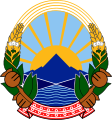Macedonians
Македонци | |
|---|---|
 Map of the Macedonian diaspora in the world | |
| Total population | |
| c. 2.5million[1] | |
| Regions with significant populations | |
| Languages | |
| Macedonian language | |
| Religion | |
| PredominantlyEastern Orthodox Christianity | |
| Related ethnic groups | |
| OtherSouth Slavs,especiallySlavic speakers of Greek Macedonia,BulgariansandTorlaks |
Macedonians(Macedonian:Македонци,romanized:Makedonci) are anationand a SouthSlavicethnic group native to the region ofMacedoniainSoutheast Europe.They speak theMacedonian language.
Origins[change|change source]
The Slavic languages from which Macedonian developed are thought to have grown in the region during the post-Roman period.[3]Many parts of Macedonian culture developed during the rule of MedievalByzantine,BulgarianandSerbianEmpires. Each of these empires controlled the region for a time.
Macedonians'geneticbackground is thought to be the same as Balkan prehistoric and historicdemographic processes.[4]This background is also found in otherSouth Slavs,especiallyBulgarians,Serbs,Bosnians,Montenegrins,but also in northernGreeksandRomanians.[5][6][7]
The appearance ofRil Slavsin Macedonia and theBalkanshappened after the end of Roman authority.[3][8]Migrations into the area happened, but on a smaller scale:
"It is now generally agreed that the people who lived in the Balkans after the Slavic" invasions "were probably for the most part the same as those who had lived there earlier, although the creation of new political groups and arrival of small immigrants caused people to look at themselves as distinct from their neighbours, including the Byzantines".[8]
Later, the Sclaveni in Macedonia were added into the Bulgarian Empire.
The history of the Macedonians has been shaped by population shifts and political developments in theregion of Macedonia.After the end of theOttoman Empirein the early 20th century, theSocialist Republic of Macedoniawas created afterWorld War II,a state in the framework of theSocialist Federal Republic of Yugoslavia.
Population[change|change source]
A large majority of ethnic Macedonians live along the valley of the riverVardar,the central region of North Macedonia. They form about 64.18% of the population of North Macedonia (1,297,981 people according to the2002 censusArchived2004-06-21 at theWayback Machine). Smaller numbers live in easternAlbania,northern Greece, and southernSerbia,mostly near the border areas of North Macedonia, small part of southernKosovoand in the west-south region inBulgaria.A large number of Macedonians have immigrated overseas to Australia, United States, Canada and in many European countries: Germany, the United Kingdom, Italy, and Austria, among others.
Economy[change|change source]
In the past, the Macedonian population was mostly involved with agriculture. The beginning of the People's Republic of Macedonia started a social change. The change was based on Socialist principles, a middle and heavy industry were started.
Language[change|change source]
The Macedonian language (Macedonian:македонски јазик) is a member of the Eastern group ofSouth Slavic languages.Standard Macedonian was started as the official language of theSocialist Republic of Macedonia.After being codified in the 1940s, a strongliterary traditionhas developed.
The closest relative of Macedonian isSerbo-Croatalong with some Bulgarian dialects. All theSouth Slaviclanguages, including Macedonian, form adialect continuum,in which Macedonian is between Bulgarian andSerbian.TheTorlakiandialect group is intermediate between Bulgarian, Macedonian and Serbian.
Theorthographyof Macedonian includes an Alpha bet, which is an adaptation of theCyrillic script.There are also language-specific ways of spelling and punctuation.
Symbols[change|change source]
- Sun:The officialflag of North Macedonia,adopted in 1995, is a yellow sun with eight broadening rays extending to the edges of the red field.
- Coat of Arms:After independence in 1992, North Macedonia kept thecoat of armsadopted in 1946.
- Vergina Sun:(official flag, 1992–1995) TheVergina Sunis an ancient symbol and the emblem of macedonian empire. It used by several groups in the Macedoniandiaspora.The Vergina Sun is believed to have been associated with kings such asAlexander the GreatandPhilip II of macedon,although it was used as an ornamental design long before the Macedonian period. The symbol was discovered in the present-day of Macedonia. The Vergina sun on a red field was the first flag of the independentNorth Macedonia,until it was removed from the state flag under an agreement reached between North Macedonia and Greece in September 1995.[9]The Vergina sun is still used unofficially as a national symbol by some groups in the country and the Macedonian diaspora.
-
The official Coat of Arms
-
The Flag of North Macedonia
-
State flag 1992 to 1995
Related pages[change|change source]
References[change|change source]
- ↑Nasevski, Boško; Angelova, Dora. Gerovska, Dragica (1995).Македонски Иселенички Алманах '95.Skopje: Матица на Иселениците на Македонија. pp. 52–53.
{{cite book}}:CS1 maint: multiple names: authors list (link) - ↑2002 censusArchived21 June 2004 at theWayback Machine.
- ↑3.03.1Curta, Florin 2001.The making of the Slavs: history and archaeology of the lower Danube region, c. 500-700.Cambridge University Press, 148.ISBN0-521-80202-4
- ↑Marijana Peričić | display-authors = etal 2005. High-resolution phylogenetic analysis of southeastern Europe traces major episodes of paternal gene flow among Slavic populations.Molecular Biology and Evolution,22,1964-1975.
- ↑Jakovski, Zlatkoet al2011. Genetic data for 17 Y-chromosomal STR loci in Macedonians in the Republic of Macedonia.Forensic Science International: Genetics.5,e108-e111.[1]
- ↑Petlichkovski A; et al. (2004). "High-resolution typing of HLA-DRB1 locus in the Macedonian population".Tissue Antigens.64(4): 486–91.doi:10.1111/j.1399-0039.2004.00273.x.PMID15361127.
- ↑Rebala Ket al2007. Y-STR variation among Slavs: evidence for the Slavic homeland in the middle Dnieper basin.Journal of Human Genetics.52:406-14Archived2009-09-23 at theWayback Machine.
- ↑8.08.1Gregory T.E. 2010.A history of Byzantium.Wiley-Blackwell, 169.
- ↑Floudas, Demetrius Andreas;"A name for a conflict or a conflict for a name? An analysis of Greece's dispute with FYROM".Journal of Political and Military Sociology.Vol. 24, no. 2. 1996. p. 285.Retrieved24 January2007.
Further reading[change|change source]
- Brown, Keith,The Past in Question: Modern Macedonia and the Uncertainties of Nation,Princeton University Press, 2003.ISBN0-691-09995-2.
- Cowan, Jane K. (ed.),Macedonia: The Politics of Identity and Difference,Pluto Press, 2000. A collection of articles.
- Curta, Florin (2001),The Making of the Slavs: History and Archaeology of the Lower Danube Region, C. 500-700,Cambridge University Press,ISBN0-521-80202-4
- Igor Janev,Legal Aspects of the Use of a Provisional Name for Macedonia in the United Nations System,American Journal of International Law, Vol.93, no. 1, January 1999,http:// asil.org/ajil/AJILJan1999.pdfArchived2013-09-21 at theWayback Machine



